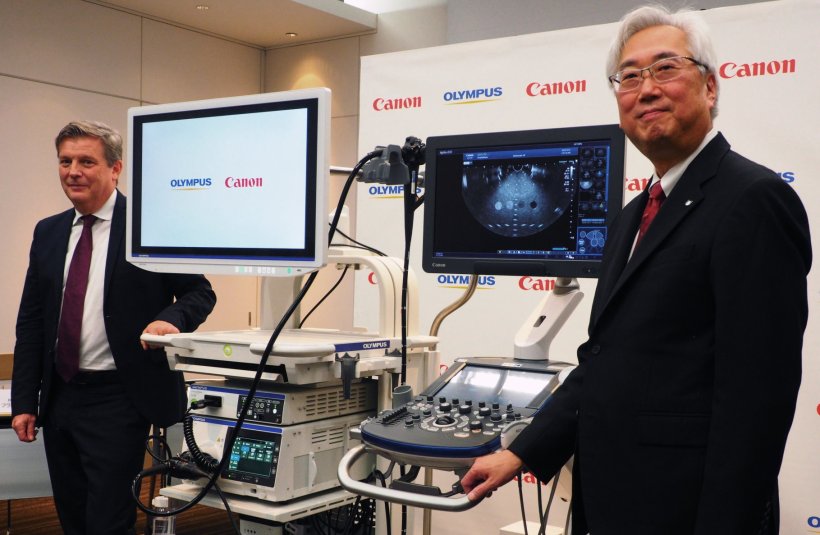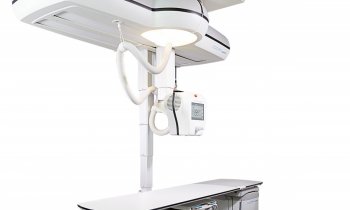
Image source: Olympus
News • Diagnostic imaging collaboration
Canon Medical Systems and Olympus team up for endoscopic ultrasound
Two major players in diagnostic imaging combine their expertise in the field of endoscopic ultrasound (EUS): At a press conference in Tokyo, Japan, Canon Medical Systems Corporation and Olympus Corporation announced their collaboration agreement, which includes introduction of a new, jointly developed ultrasound system that takes advantage of both companies’ experience in endoscopy and sonography.
As part of the collaboration, Canon Medical will develop and manufacture diagnostic ultrasound systems for EUS procedures, while Olympus will perform the sales and marketing efforts. With the traditional handshake, Frank Drewalowski, Head of the Endoscopic Solutions Division at Olympus, and Toshio Takiguri, President and CEO of Canon Medical, affirmed the agreement. Both expressed their enthusiasm for the collaboration, highlighting the two companies' rich history of technological innovation in the respective fields of endoscopy and diagnostic ultrasound. In this new constellation, both manufacturers aim to expand their business in diagnostic imaging markets, including Europe.
Image quality to rival CT and MRI

Image source: Olympus
In a first demonstration of the cooperation, the companies unveiled a combined setup of Canon's Aplio i800 diagnostic ultrasound system for EUS and Olympus' Ultrasound Endoscope. Equipped with Canon’s proprietary imaging enhancement features such as differential tissue harmonic imaging (D-THI), superb micro-vascular imaging (SMI), shear-wave elastography (SWE) and attenuation imaging (ATI), the system can be used as a tool for a wide range of imaging applications.
Taking full advantage of the technology, the combined EUS setup is designed to provide superior image resolution and quality compared to CT and MRI, Takiguri said. With the new device, the companies hope to enhance diagnostic efficiency, for example in the detection of smaller lesions in pancreatic cancer and bring benefits in other pancreatobiliary diseases, which affect more than 60 million patients worldwide, added Drewalowski.
Endoscopic ultrasound – which combines a sonography probe to the tip of an endoscope to assess diseases of the gastrointestinal tract and nearby organs, such as the liver, pancreas and gallbladder – has a range of diagnostic applications, said Hironobu Kawano, Endoscopic Solutions Division Head at Olympus. However, the modality is often considered tricky, requiring a high level of expertise in sonography. The enhanced imaging features in the new EUS system allow for more consistent image quality and improve access for difficult-to-reach areas of the body, he pointed out.
Going into more detail on the technology, Akihiro Sano, General Manager of the Ultrasound Systems Division at Canon Medical Systems, showcased the strengths of the embedded features: D-THI provides clearer images at greater depths, while SMI shows more and thinner vessels compared with conventional Doppler ultrasound, enabling a better visualisation of blood flow. Further, ATI is used to quantify and color-code changes in the tissue composition (e.g., fat content of the liver).
Coming to European markets this summer
‘We have a long history in diagnostic ultrasound systems and have developed unique technologies that contribute to the early detection of diseases in cooperation with doctors around the world,’ Takiguri said. ‘We are very pleased to collaborate with Olympus, a leading endoscope manufacturer, in the EUS field, which we have not been able to cover adequately until now, to deliver superior solutions to more patients.'
Drewalowski added: ‘In the field of EUS, diagnostic ultrasound systems are very important, and we are pleased to have a cooperative relationship with Canon Medical, which has advanced ultrasound imaging technology.’
Introduction of the EUS system to European and Japanese markets is planned for June 2024, Takiguchi said, while the timeline for US markets is still pending. (WB)
15.01.2024











